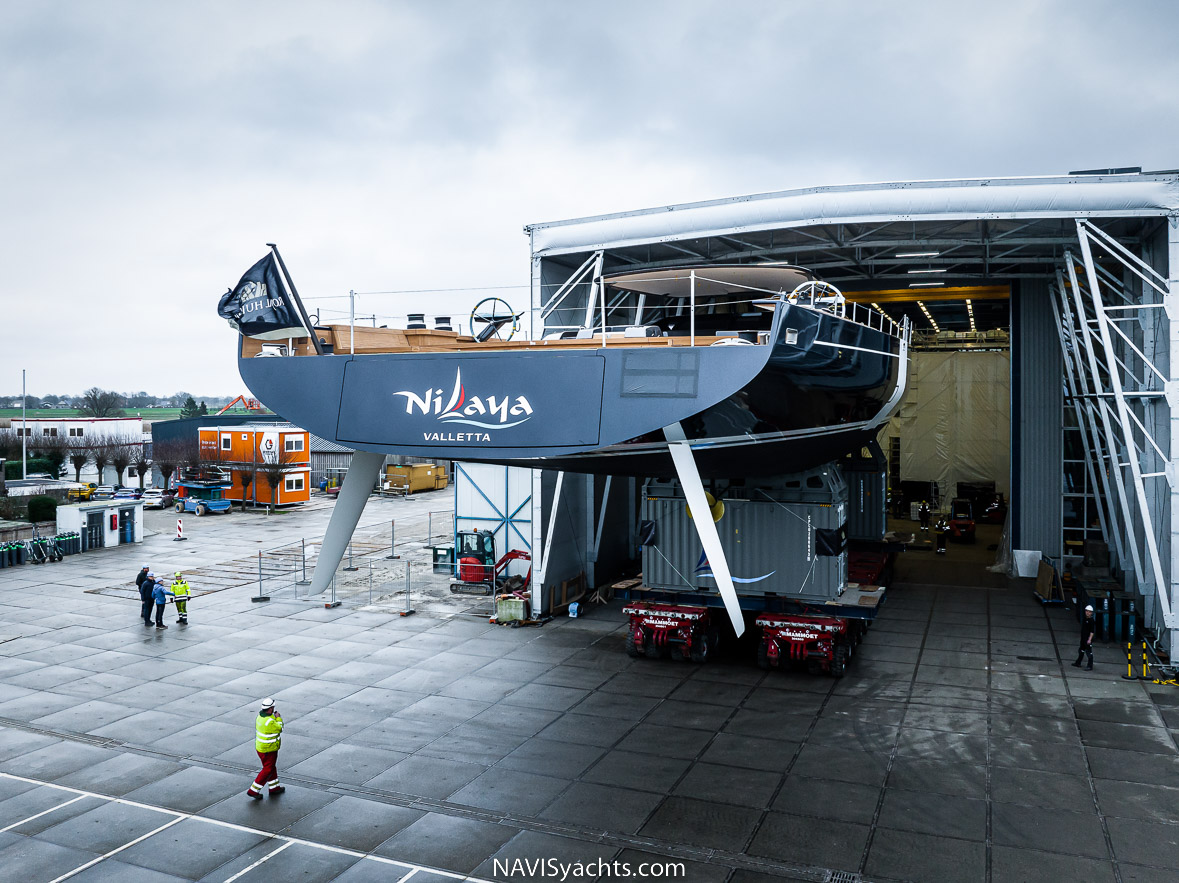Project 405, aka Reichel / Pugh - Nauta 154, the Panamax sloop Nilaya, took a giant step forward with her departure from construction at Royal Huisman’s Vollenhove facility. This superyacht is the first to feature the builder’s Featherlight™ design and production method, reducing 11% of the weight compared to their aluminum cruising yachts without compromising stiffness or quality. It was achieved through a range of lightweight solutions combined in a holistic approach that makes Nilaya an ideal high-performance cruiser. As she heads toward Amsterdam for her towering rig installation, we eagerly await her maiden launch.
The Featherlight™ process employs Finite Element Analysis (FEA), an engineering methodology commonly used in spacecraft design. Leveraging FEA, our team strategically selected construction materials and varying Alustar aluminum plate thicknesses and frame spacings, resulting in increased hull stiffness without significantly increasing boat displacement. In-house weight management was also utilized to optimize mechanical systems, lighting, and insulation to get the most out of our design. Further still, lightweight foam coring was employed for all interior structural members for further weight reduction with minimal sacrifice of sailing performance.

To bring its carbon fiber mastery and Rondal’s experience to the table, Royal Huisman decided to use composite and aluminum for various structural components. To highlight a few, the coachroof, guest cockpit structure, tender well on the foredeck, watertight bulkhead, crew entrance, twin rudders, the keel trunk, and a cockpit bimini hardtop were all crafted out of carbon composite. For any high-performance cruiser, having a low center of gravity is key; thus, this model was designed with a carbon mast, boom, and standing rigging — typically used by maxi-racers. It is an ambitious effort but one that pays off in spades.
Nilaya’s striking design, with her low-slung profile, pronounced bow, a wide transom and twin rudders, is based on the highly successful maxi race yachts of the same name. Her developers employ an impressive team of naval architecture and design experts - Reichel/Pugh and Nauta - to ensure a performance cruiser that lives up to its potential. Utilizing CFD (computational fluid dynamics) technology to optimize both carbon fiber and aluminum hulls, yacht builders crafted the Featherlight™ building method as an expression of nearly 60 years’ worth of experience with each material. In the end she is custom-built for their owners with no compromises necessary.
MCM Newport’s own Nigel Ingram serve as the owner’s project manager for the build of Nilaya. Aiming to create a vessel for world-cruising that still had the superior handling and responsiveness of its predecessor, Royal Huisman proposed outfitting her with Alustar aluminum. As a material, it helps reduce noise and provides supreme comfort when sailing to remote sites. That said, they also felt it was possible to engineer a lighter aluminum high-performance vessel - investing extensively in research in an effort to save weight and explore innovative possibilities. Working closely with Reichel/Pugh on the target weight parameters, Nauta Design was ultimately able to craft an exceptional superyacht without compromising performance or design ambitions.
Royal Huisman CEO Jan Timmerman wanted to celebrate both the revolutionary construction methods and the recent development of Project 405. He proudly remarked that these innovations have paved the way for future builds. Advanced engineering has been a core part of this success, as have teams from Royal Huisman and Rondal who continually came up with new techniques to satisfy their clients’ needs. The owners are also worthy of recognition for encouraging creativity throughout the process. Boat 405, now named Nilaya, will be one of the lightest aluminum sailing superyachts in existence – something that seemed impossible before now!
The magnificent 154-foot cruiser sloop Nilaya left the Vollenhove facility of her builder, Royal Huisman, last week. Project 405, also referred as Reichel / Pugh - Nauta 154 was then moved to the shipyard’s deepwater location in Amsterdam, before being successfully launched on February 6th.

























